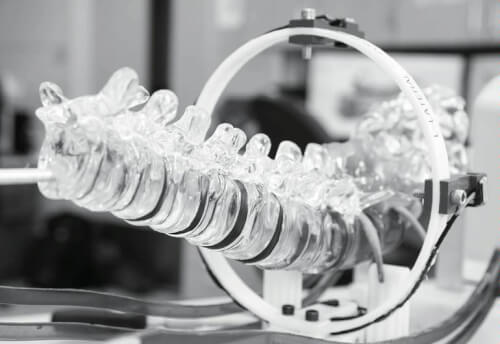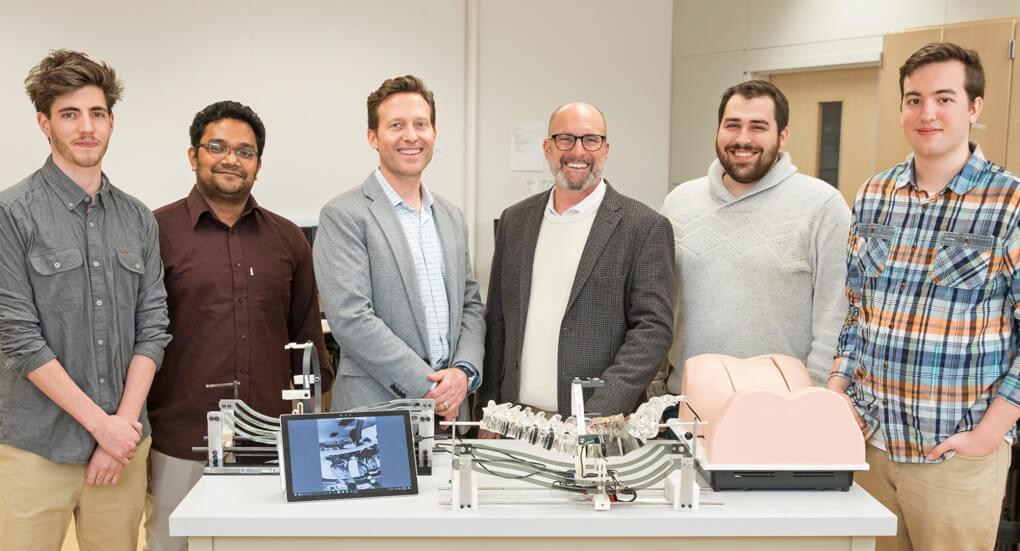On a top level of the Cook-DeVos Center for Health Sciences, a group of students and staff members can be found building and testing new product ideas that could better human health and well-being.
The space is the location of the applied Medical Device Institute (aMDI), a new Grand Valley center located on the Medical Mile that is supporting Grand Rapids’ growing medical research and biomedical industries by bringing medical device inventions to market.
aMDI is a first-of-its-kind center in West Michigan that provides companies and inventors with access to researchers, engineers, entrepreneurs, and medical and business professionals. It uses an integrated approach that includes intellectual property, business review and mentorship.
Brent Nowak, executive director of aMDI, said the center fills a much-needed gap in West Michigan.
"Grand Rapids has the ideas, the engineers to design them and the manufacturers to build them, but the area is missing a central group that focuses solely on developing and guiding those medical device ideas and inventions to the point where they are ready to be mass produced and marketed," said Nowak.
The center has been a few years in the making. It officially opened in 2016.
Nowak, a native of Jackson, has founded several medical device companies and spent 25 years developing intelligence systems for organizations across the country. He came to Grand Valley in 2013 and noticed the need for an enterprise that can mature ideas from conception to commercial viability.
FROM CONCEPT TO REALITY
The institute serves a variety of clients, from individual inventors to large organizations. One of its first clients was a Spectrum Health Innovations-Grand Valley team that invented the female urinary collection device. The device is designed to lower the number of infections women experience from an indwelling catheter. The idea came from a Spectrum Health nurse and the first prototype was created by a group of Grand Valley engineering students in 2014. aMDI was sought out to take the device to the next level; it’s now going through clinical trials.

Brent Mulder, senior director of SHI, said working with aMDI has been a natural fit.
"We relied on Brent (Nowak) and his team to look at the next steps required to bring the product to market. That includes creating a manufacturing plan, testing new prototypes and making recommendations," said Mulder.
aMDI’s lengthy client list includes Encoris, a company located in Holland that designs and manufactures medical models and surgical trainers for medical device companies around the world. aMDI helped Encoris develop the S2T Surgical Smart Trainer, a unique device that improves the way surgeons are trained for spinal surgery.
Encoris' co-founder, Jim TenBrink, graduated from Grand Valley in 1997. He said the device will provide safer and more cost-effective training for students at teaching hospitals and medical schools.
"The use of cadavers for surgical training is a method that has been around forever — it’s 19th-century technology," TenBrink said. "We want to take surgical training to the 21st century."
TenBrink said the prototype he presented to aMDI was lacking the X-ray visuals surgeons need in order to train outside cadaver labs. The aMDI team converted four cameras into lifelike X-ray visuals, visible in real time.
"There's not a trainer in the world that can do that," TenBrink said. "It's a game-changer, a time- and money-saver, and it's saving lives because they're not being subjected to radiation. I couldn't be more thrilled with the level of knowledge and expertise the students and faculty provided."
Recently, aMDI worked with Sterilogy to create a series of devices that could help reduce and eliminate hospital-associated infections. Michigan-based Sterilogy patented a compact, hand hygiene system that is worn on the hips of medical staff; aMDI is building prototypes and testing the devices.
"Just like the Encoris project, it requires us to engage mechanical, software and computer engineering because we're developing very sophisticated electronics," said Nowak.

Student engagement
Project teams are multidisciplinary and often include students and faculty members from engineering, biology, marketing, biomedical sciences and computer science.
Spencer Adamczyk, a sophomore majoring in biology and education, works for aMDI and is responsible for testing prototypes and conducting market research.
"I didn't know much about the medical device industry before working for aMDI," said Adamczyk, from Oxford. "I've learned so much, like new terminology and how to use manufacturing machines."
Adamczyk often works with Cody Rash, a recent alumnus who received a bachelor's degree in biomedical sciences and went on to graduate school. Rash was one of the first students Nowak hired.
"It was just me and one other student," said Rash, from White Lake. "It's been great to see how much we've been able to grow in such a short amount of time. It was rewarding to be a part of a group that created new, well-rounded devices that will help save lives."
Nowak said alumni who worked at aMDI have found jobs all over the country. Joe Kissling, for example, works for NanoRocks in Webster, Texas. The company is a NASA contractor and operates a commercial laboratory in outer space.
Kissling, from San Antonio, will soon graduate from Grand Valley with a master's degree in mechanical engineering. At aMDI, he worked with Nowak to take new ideas and develop them as proof of concept.
For his master's thesis, he designed a robotic skeleton to assist astronauts in their work in space and presented it to NASA. He said spacesuits are extremely difficult to work in, and his design will help alleviate the stress on their bodies and make it easier to move in space.
“It's very satisfying to know that your products are going to provide a higher quality of life or save a life.”
BRENT NOWAK, EXECUTIVE DIRECTOR OF AMDI
Looking ahead
Nowak said 2018 will be his tsunami. He predicts that aMDI will double in size.
In 2016, Nowak hired three graduate students, two undergraduate students and a full-time engineer. In 2017, aMDI employed 27 students, engaged 10 faculty members in six departments, worked with 10 health care and industry clients, and took on 12 new projects.
"You could say that word travels fast," said Nowak. "It'll take another three-to-five years for us to become fully sustainable, but we are demonstrating our continuous growth through each project. It's exciting to see all the enthusiasm for aMDI from the West Michigan community."
Nowak said he enjoys seeing students learn in the lab and have a hand in saving lives.
"It's an absolute joy to work with students," he said. "They are full of energy and new ideas. It's very satisfying to know that your products are going to provide a higher quality of life or save a life."







